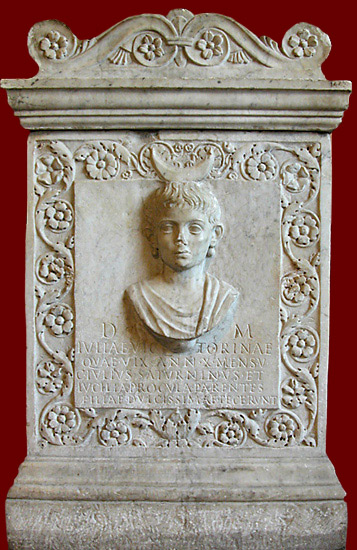
Marble Funerary Altar, end 1st century CE

While Julia Victorina is only one child in the unhappy statistic that half of all Roman children died by the age of ten, her death in the last quarter of the 1st century CE is personalized by the unique and costly monument her parents set up in her memory. With this elegant altar, now in the Louvre Museum in Paris, Gaius Julius Saturninus and Lucilia Procula, who are otherwise unknown by rank, ancestry, or situation, memorialized their grief and hopes for a young daughter taken from them prematurely. The monument would have been placed in a family tomb and held a cinerary urn containing the child's ashes. It is a rectangular block of white marble, elaborately carved on all four sides and crowned by a marble cover gracefully decorated with motifs (mouldings, volutes, and blossoms) that echo those carved on the front and back of the lower stone. The front of the altar bears the dedicatory inscription and features a portrait bust in high relief of the lovely face of a girl, framed by a wide border of acanthus leaves and variegated flowers, symbols in the Mediterranean world of eternal life. Julia Victorina, gazing pensively off to her right, wears ball-shaped pendent earrings, probably of gold; her shoulders are draped, her hair is styled almost boyishly and is crowned by a crescent moon, at once a symbol of eternity and association with Diana in her role as the moon-goddess. On the back of the altar she appears again, similarly framed with botanicals, but now as a young matrona, as her parents had hoped in a few years to enjoy her; her face is solemn and thinner but recognizable as the child she was. She looks directly at the viewer, wearing the married woman's stola, a palla draped over one shoulder and the same pendent earrings; her hair is arranged in a more matronly style, topped by a radiate crown that symbolizes her apotheosis in the heavens and her immortality. The short sides of the altar are decorated with a flourishing laurel tree, an evergreen sacred to Apollo, god of the sun; within its branches hover two birds, possibly ravens, his sacred bird, seen here together with laurel-crowned Apollo in his shrine. This extraordinary altar, with its portrait busts and floral designs promising immortality, offers moving testimony to the grief of Victorina's parents over the loss of a beloved child.
The dedicatory inscription is crowded into the space below the child’s bust, which awkwardly divides the girl's cognomen. The words are written in square capitals over five lines of diminishing size, with prominence given to the Di Manes and the girl's name. The letters are well formed and centered, with medial dots (interpuncts) separating the words in lines 3-6.
QVAE• VIX[it]• ANN[is] • X• MENS[ibus]• V•
C[aius]• IVLIVS• SATVRNINVS• ET
FILIAE• DVLCISSIMAE• FECERVNT
Click on the underlined words for translation aids and commentary, which will appear in a small window.